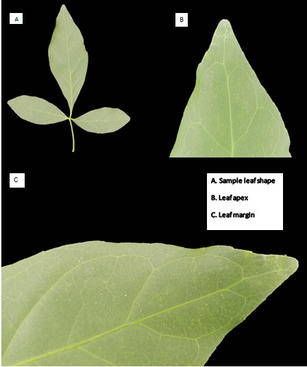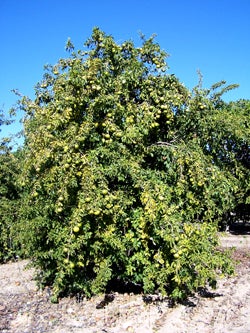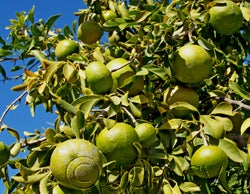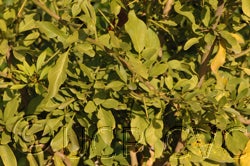Nigerian powder-flask fruit
CRC 4033
PI 607466
Source
Received as seed from Liberia, Ivory coast, Ghana, Dahomey, Nigeria, 1992
Parentage/origins
Parents unknown. Originated from seed obtained from Dr. Prevatt at Florida Southern College.
Rootstocks of accession
Own roots.
Season of fruiting at Riverside
August to December
Season of flowering at Riverside
June to July
Description from The Citrus Industry Vol. 1 (1967):
"In 1912 Swingle quoted a detailed description of this plant by Chevalier. It reads as follows (in translation from the French): "Tree 8-15 m high, branching 1.5-2 m above ground. Trunk 25-40 cm diam., bark brown, lightly split longitudinally. Branches numerous, spiny, making a rounded head like an orange tree. Young twigs green, slender, glabrous, spines straight, very sharp, 12-18 mm long, occurring in the axils of some leaves.
"Leaves alternate, 3-foliolate or, by exception, 1-foliolate by abortion, 8-16 cm long, completely glabrous. Leaflets similar, oboval or oblong, cuneiform at base, rounded or alternate, subacute at the apex, sometimes retuse, lightly crenulate in the upper half or 2/3 of the margin, firm or subcoriaceous, a beautiful green color both above and below, central leaflet a little larger than the lateral ones, measuring 4.5-11 cm long and 2.5-5.5 cm broad, borne on a petiole 5-30 mm long, articulated at the two ends, lateral petioles 2-10 mm long. Inflorescences small, axillary panicles, 4-6 cm long, few-flowered (6-10 fls.), isolated at the axil of the leaves or inserted on parts having already lost their leaves. Rachis and pedicels glabrous green, pedicels 2-3 mm long. Flowers white, with a strong odor of 'berlingot,' glabrous, buds ovoid. Calyx cyathiform, 3-4 mm long with 4 short lobes rounded and irregular. Petals 4, oval, oblong, rounded at the apex, greenish outside, white inside, 10-13 X 4-6 mm, curved backward. Stamens 15-20 (usually 16), filaments free, white, fusiform, erect, 4-5 mm [long]; anthers oblong, 2.5 mm long. Disk greenish-stipulate, slightly lobed. Ovary ovoid, greenish, divided into ±8 locules. Stigma ovoid, glandular, 3 mm long, borne on a very short style.…
"Fruit globose or obovoid, sometimes slightly stipulate at base, almost always depressed at the top, as large as a big orange (6-8 cm diam. when mature), wrinkled on the surface, sometimes tuberculous, without odorous glands.
"Pericarp hard, 4-5 mm thick, resembling the pericarp of large fruited Strychnos, remaining green when mature, then becoming grayish.
"Segments 8 (!) with smooth walls (not covered with fleshy hairs). Each segment contains numerous seeds irregularly arranged in 2 or 3 rows, inserted in the placenta, axillary and in orderly arrangement, tegument whitish, parchment-like."
Fresh flowers of Afraegle paniculata from a tree grown in the citrus greenhouse of the former Bureau of Plant Industry at Washington, D.C. , were compared on July 10, 1937, with fresh flowers of A. gabonensis grown in the same greenhouse. They showed the following points of difference: Inflorescences of A. paniculata much longer, but pedicels slightly shorter (3 to 4 mm long); flowers about the same size as those of A. gabonensis; calyx not flat and discoid but cup-shaped with 3 to 5 clearly marked, very bluntly pointed lobes, finely ciliate at the apex; petals very similar to those of A. gabonensis; stamens similar but in A. paniculata nearly four times as numerous as the petals (often one or two short of this number), whereas in A. gabonensis three times as many (or a few short); disk smaller, about 3.5 to 4.5 mm wide and 1.5 mm high, pea-green instead of yellowish-green, as in A. gabonensis.
This tree, which reaches a height of 15 meters, is often planted by the natives in their villages in Dahomey and Nigeria. The seeds are said to yield an edible oil and the leaves are sometimes macerated and added to the water used for bathing. In the United States, this species grows well in the greenhouses of the U.S. Department of Agriculture and sometimes flowers, but so far has not borne fruit. In the quasi-tropical coastal region near Miami, Florida, which has an unusual type of soil consisting largely of porous-limestone rock intermingled with fine sand or very sandy loam, this species, when well fertilized, makes extraordinary growth—probably ten times as fast as in the Washington greenhouse. A tree growing near Coconut Grove, when only four or five years old and only 5 feet (1.6 to 1.8 m) high, had a lateral spread of 15 to 20 feet (4.5 to 6 m). As it grew older, this tree became much taller but still had long branches. Afraegle paniculata grows in the Miami region much more rapidly than Aeglopsis chevalieri (another vigorous but dwarfish West African Hard-Shelled Citroid Fruit Tree), and is being tested as a rootstock for the bael fruit Aegle marmelos, a species which often does not grow well on its own roots."
Availability
Not commercially available in California.
USDA Germplasm Resources Information Network page for Afraegle paniculata



